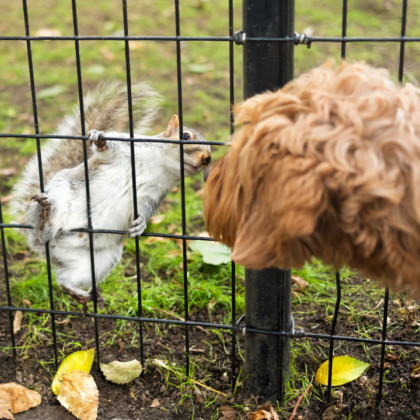Here’s a question I ask handlers all the time: “Is your dog’s mind in the same place as their feet?”
A dog may be right next to you. Their feet are with you, but their minds are somewhere else, sorting out stimuli that may be fascinating, worrisome, alarming, overwhelming, exciting, frustration, threatening or downright scary.
This can be as simple as a dog thinking about the cheese in your treat pouch, or the squirrel in the tree, or the dog that just came around the corner. It can be as complicated as a dog becoming alarmed by the joggers headed your way, even if you didn’t see them.
Communication works best when head and feet are in the same place. When the mind is elsewhere, the conversation can go sideways.
You: “Hey dog – would you please sit?”
Dog (staring at squirrel): “ “
You: “Sit!”
Dog (still watching squirrel): “Huh?” Turns one ear towards you.
You: “SIT!”
Dog turns head towards you and wags tail briefly, resumes watching squirrel.
You: “Oh, she’s just so distracted!”
While we may think of this as the dog being “distracted” by x, y or z, the truth is that the dog is focused. Just not on the handler.
Depending on the dog, that focus elsewhere can be mild and the dog able to re-engage with the handler fairly quickly. Or the stimuli can trigger intense reactions, leaving the dog unresponsive to accepting direction from the handler.
One hallmark of reactivity is that the dog is strongly engaged with triggering stimuli, and disengaged from the handler, a sign that the dog is over threshold and unable to respond. This is not a training moment. It is time for the handler to manage the dog until the dog’s mind is back in the same place as their feet.
Want to learn more? We have two webinars we think you will like!
- Anatomy of Attention – The world is full of distractions for our dogs. This can make training challenging, even frustrating for us, and for our dogs. Yet distractions offer us the best opportunities to strengthen behaviors and teach our dogs to focus IF we know how to introduce distractions in a way that promotes thoughtful choice, builds confidence and is respectful of our individual dogs.
- Distractions and – SQUIRREL! . . . Using Them in Training – Armed with an understanding of the anatomy of attention and the individual dog, we can align our goals and expectations with who that dog truly is. When we know how to engage the astonishing power of intrinsic motivation, we can —– SQUIRREL! (Just kidding…unless you are really into squirrels?) — make the most of every dog’s capacity for attention

